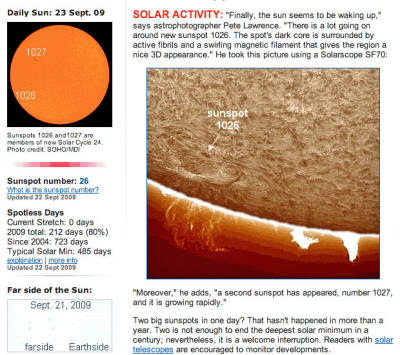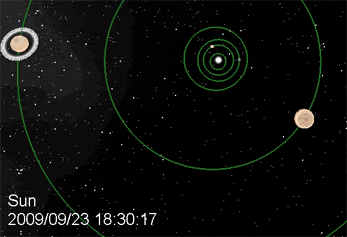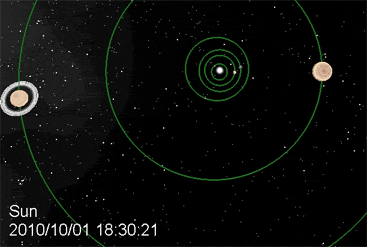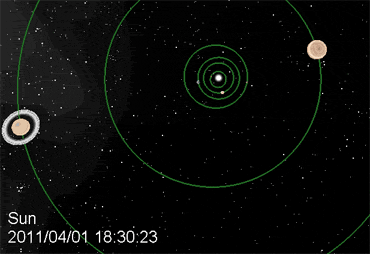|

by Montalk
September 23, 2009
from
Montalk Website
Back in January 2009, I looked into correlations between planetary
positions and flu pandemics.
Another thing I checked was correlation between planetary positions
and solar activity like sunspots and coronal mass ejections (CMEs).
It quickly became clear that Jupiter and Saturn were the main
players, with Uranus and Earth providing a lesser role.
According to
David W. Allan, itís not the mass of the planets so
much as their magnetic fields that determines solar activity. This
makes perfect sense when you look at the data. His
other article
goes into greater detail.
To accurately predict solar activity, one would need to model the
magnetic field of the main planetary contributors and how these
fields combine within the sun. I donít have the data to make such a
model, but I can still look at a solar system simulator and see what
planets are where, whether their north magnetic poles are angled
toward or away from the sun, and determine a window of time in which
solar activity ought to be heightened.
For instance, Jupiter on one side with north pole toward, and Saturn
on the opposite side with south pole toward the sun, would create a
strong magnetic circuit going through the sun, which will stimulate
sunspots and thus solar flares. Same with Jupiterís (or Saturnís)
relations with Earth and Uranus, although those alignments are
weaker in their effects.
So from my analysis in January, it looked like the sun could become
active in August/September 2009.
In early February I made mention of
it
here where I said,
ďThe sun will wake up in late August to early
September of 2009 and spit out some nice flares.Ē
Then
in early July, I posted more information accompanied by the
following graphic to show upcoming alignments relevant to solar
activity.

So with today being September 23, 2009 there ought to be some
resurrection in solar activity. The sun has been unusually quiet for
more than a year.
As I wrote in the July post,
ďThe biggest field contributers are Jupiter, Saturn, and Uranus. For years these have
been out of any significant alignments. Only starting this late
summer and fall is it getting interesting again.Ē
Here is the current screenshot from
spaceweather.com:

This alignment is weak.
Just enough to stir up the sun, but nothing
like what happens during an actual solar peak because the alignment
between Jupiter and Saturn is mediocre:

Therefore, the sun ought to quiet down again once the other
September alignments pass.
Now fast forward to late 2010 and early
2011:


As you can see, Fall 2010 through Spring 2011 should have high solar
activity because Jupiter and Saturn are aligned.
That means lots of
sunspots, solar flares, and geomagnetic storms.
This also means
disruptions to the jet stream, increased tectonic activity, extreme
weather, and hyper-dimensional effects like perturbations of human
consciousness and increased likelihood of tension, conflict, and
stress.
Others have written about this as well, see for example
this
article by Buryl Payne.
Of course, there have been solar peaks in the past and the world is
still around; thatís not the issue. The issue is the conditions and
context in which this next peak will take place. For example, view
it in context of what others like Gerald Celente are predicting for
the years ahead (below video).
All this does is help narrow down the timing, for
those who wish to know.
This is the reason why Iím posting about the planet/sun correlation,
because it predicts when the next solar peak ought to occur, and
thus when the next major intensification of human-human tensions
ought to take place.
UPDATE
I wrote a program to calculate the angular separation
between Jupiter and Saturn. Zero and 180 degree separations
correlate with the center of all solar cycles going back several
decades.
So with that, Iím able to predict the characteristics of
Solar Cycle 24.
It is as follows:
-
Spring 2010: start of upward slope
-
Fall and Winter 2010: first peak
-
Spring 2011: central point of cycle
-
Summer 2011 to Spring 2012: second peak
-
Summer 2012 to Summer 2013: downward slope
The initial upward slope is steep, peaks, dips a little around the
central point, then peaks again, and starts sloping downward more
gently. So the second half is extended compared to the first half.
Thatís why the second peak and downward slope last longer than the
first.
During the downward slope, solar flares and sunspots grow less
frequent, but with potentially stronger X-class flares even though
they are fewer and farther between.
During the last cycle, the
downward slope was well underway by 2003 when some whopper sunspots
and flares appeared. This corresponds to mid
2012 to mid 2013 in the
upcoming cycle.
We could see a major CME event around this time, which if strong
enough could
knock down the electric grid and make things all the
more interesting. Visit
empcommission.org to read a
government-funded study on how society would be affected.
Itís worth noting that military black projects ought to have enough
computing power to accurately predict (but not reveal to the public)
when the next major CME event will hit, when electric and
communications infrastructure will go down.
This would allow them to
prepare far in advance and capitalize on that knowledge. Maybe they
would need widespread blackouts to conduct questionable operations
that could not be pulled off under the light of media and internet
awareness.
Timing of the next solar peak should indicate when such a
scenario is likely to manifest.
|





